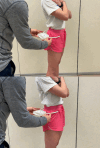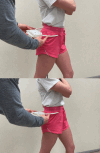Clinical Measures of Pelvic Tilt in Physical Therapy
- PMID: 34631258
- PMCID: PMC8486407
- DOI: 10.26603/001c.27978
Clinical Measures of Pelvic Tilt in Physical Therapy
Abstract
Pelvic tilt refers to the spatial position or motion of the pelvis about a frontal horizontal axis on the rest of the body in the sagittal plane. It is relevant for several musculoskeletal conditions commonly seen in physical therapist practice, particularly conditions affecting the hip and groin. Despite the relevance of pelvic tilt identified in biomechanical studies, and the historical precedence for assessing pelvic tilt, there is a lack of clarity regarding the utility of clinical measures that are practical in a rehabilitation setting. There are several options available to assess pelvic tilt which are discussed in detail in this commentary. All of these options come with potential benefits and considerable limitations. The purpose of this commentary is to provide an overview of the relevance of understanding pelvic tilt in the pathology and rehabilitation of conditions affecting the hip joint, with a focus applying evidence towards identifying clinical measures that may be useful in the rehabilitation setting and considerations that are needed with these measures.
Level of evidence: 5.
Keywords: groin; hip; injury assessment; movement system; pelvic tilt.
Conflict of interest statement
The author reports no conflicts of interest.
Figures



Similar articles
-
Does Patient-specific Functional Pelvic Tilt Affect Joint Contact Pressure in Hip Dysplasia? A Finite-element Analysis Study.Clin Orthop Relat Res. 2021 Aug 1;479(8):1712-1724. doi: 10.1097/CORR.0000000000001737. Clin Orthop Relat Res. 2021. PMID: 33787527 Free PMC article.
-
Does Acetabular Coverage Vary Between the Supine and Standing Positions in Patients with Hip Dysplasia?Clin Orthop Relat Res. 2019 Nov;477(11):2455-2466. doi: 10.1097/CORR.0000000000000898. Clin Orthop Relat Res. 2019. PMID: 31389893 Free PMC article.
-
Active pelvic tilt is reduced in athletes with groin injury; a case-controlled study.Phys Ther Sport. 2019 Mar;36:14-21. doi: 10.1016/j.ptsp.2018.12.011. Epub 2018 Dec 26. Phys Ther Sport. 2019. PMID: 30611026
-
Biomechanical analysis of the spino-pelvic organization and adaptation in pathology.Eur Spine J. 2011 Sep;20 Suppl 5(Suppl 5):609-18. doi: 10.1007/s00586-011-1928-x. Epub 2011 Aug 2. Eur Spine J. 2011. PMID: 21809016 Free PMC article. Review.
-
The Influence of Pelvic Tilt on the Anteversion Angle of the Acetabular Prosthesis.Orthop Surg. 2019 Oct;11(5):762-769. doi: 10.1111/os.12543. Orthop Surg. 2019. PMID: 31663281 Free PMC article. Review.
Cited by
-
Pelvic tilt and stiffness of the muscles stabilising the lumbo-pelvic-hip (LPH) complex in tensiomyography examination.PLoS One. 2024 Oct 23;19(10):e0312480. doi: 10.1371/journal.pone.0312480. eCollection 2024. PLoS One. 2024. PMID: 39441879 Free PMC article.
-
Efficacy of Task-Oriented Circuit Training on Gait Kinematics, Pelvic Symmetry and Trunk Endurance in Children with Hemiplegia: A Randomized Controlled Trial.J Musculoskelet Neuronal Interact. 2025 Mar 1;25(1):36-46. doi: 10.22540/JMNI-25-036. J Musculoskelet Neuronal Interact. 2025. PMID: 40024226 Free PMC article. Clinical Trial.
-
A New Clinical Examination Algorithm to Prescribe Conservative Treatment in People with Hip-Related Pain.Pain Ther. 2024 Jun;13(3):457-479. doi: 10.1007/s40122-024-00604-7. Epub 2024 May 3. Pain Ther. 2024. PMID: 38698256 Free PMC article. Review.
-
Clinical presentation of anterior pelvic tilt and trunk muscle endurance among patients with femoroacetabular impingement syndrome: a cross-sectional study.Eur J Phys Rehabil Med. 2024 Dec;60(6):1027-1035. doi: 10.23736/S1973-9087.24.08378-3. Epub 2024 Oct 7. Eur J Phys Rehabil Med. 2024. PMID: 39374049 Free PMC article.
-
Reliability of the Biomechanical Assessment of the Sagittal Lumbar Spine and Pelvis on Radiographs Used in Clinical Practice: A Systematic Review of the Literature.J Clin Med. 2024 Aug 8;13(16):4650. doi: 10.3390/jcm13164650. J Clin Med. 2024. PMID: 39200793 Free PMC article. Review.
References
-
- Correlation between spinal and pelvic movements during gait and aggravation of low back pain by gait loading in lumbar spinal stenosis patients. Kuwahara Wataru, Kurumadani Hiroshi, Tanaka Nobuhiro, Nakanishi Kazuyoshi, Nakamura Haruka, Ishii Yosuke, Ueda Akio, Deie Masataka, Adachi Nobuo, Sunagawa Toru. Mar;2019 Journal of Orthopaedic Science. 24(2):207–213. doi: 10.1016/j.jos.2018.09.002. doi: 10.1016/j.jos.2018.09.002. - DOI - DOI - PubMed
-
- Common musculoskeletal impairments in postpartum runners: An international Delphi study. Christopher Shefali M., Garcia Alessandra N., Snodgrass Suzanne J., Cook Chad. Oct 26;2020 Archives of Physiotherapy. 10(1) doi: 10.1186/s40945-020-00090-y. doi: 10.1186/s40945-020-00090-y. - DOI - DOI - PMC - PubMed
-
- Pelvic tilt and range of motion in hips with femoroacetabular impingement syndrome. Patel Rikin V., Han Shuyang, Lenherr Christopher, Harris Joshua D., Noble Philip C. May;2020 Journal of the American Academy of Orthopaedic Surgeons. 28(10):e427–e432. doi: 10.5435/jaaos-d-19-00155. doi: 10.5435/jaaos-d-19-00155. - DOI - DOI - PubMed
LinkOut - more resources
Full Text Sources
Research Materials
